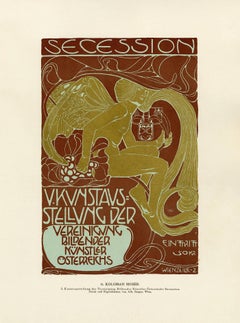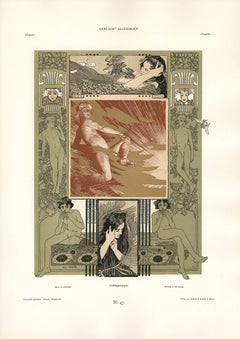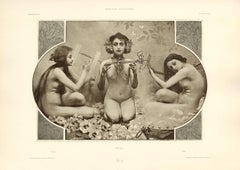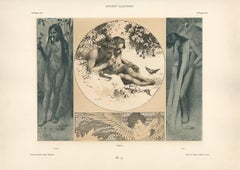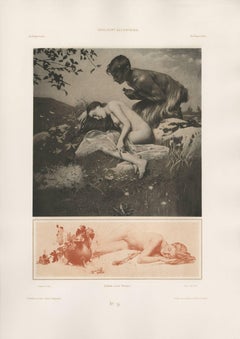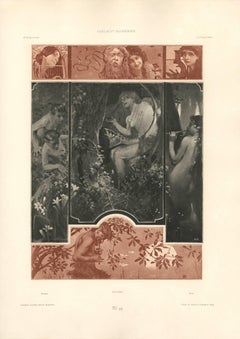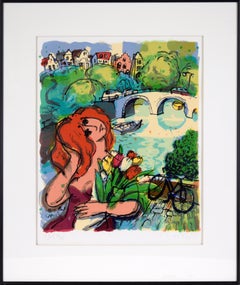Galerie Fledermaus Art
to
11
Overall Width
to
Overall Height
to
10
1
1
11
6
5
11
7
6
6
6
6
4
2
2
1
1
1
1
1
10
1
39
47
47
34
24
11
Artist: Koloman Moser
Ottokar Mascha Folio: plate 11 "5th Secession Exhibition Poster" by Kolo Moser
By Koloman Moser
Located in Chicago, IL
after KOLOMAN MOSER (1868-1918) 5TH SECESSION EXHIBITION POSTER, 1899, (In Mascha, no. 11) A pivotal figure in early-20th century Austrian ...
Category
1910s Vienna Secession Figurative Prints
Materials
Lithograph
Gerlach's Allegorien Plate #47: "Morning in the Spring" Lithograph
By Koloman Moser
Located in Chicago, IL
Koloman Moser
(1868 –1918), AUSTRIAN
Instead of applying his flair and art education solely to painting, Koloman Moser embodied the idea of Gesamt Kunstwerk (all-embracing art work) by designing architecture, furniture, jewelry, graphics, and tapestries meant to coordinate every detail of an environment. His work transcended the imitative decorative arts of earlier eras and helped to define Modernism for generations to come. Moser achieved a remarkable balance between intellectual structure (often geometric) and hedonistic luxury.
Collaborating with Gustav Klimt and Josef Hoffmann, the artist was an editor and active contributor to Ver Sacrum, (Sacred Spring), the journal of the Viennese Secession that was so prized for its aesthetics and high quality production that it was considered a work of art. The magazine featured drawings and designs in the Jugendstil style (Youth) along with literary contributions from distinguished writers from across Europe. It quickly disseminated both the spirit and the style of the Secession.
In 1903 Moser and Hoffmann founded and led the Wiener Werkstatte (Viennese Workshop) a collective of artisans that produced elegant decorative arts items, not as industrial prototypes but for the purpose of sale to the public. The plan, as idealistic then as now, was to elevate the lives of consumers by means of beautiful and useful interior surroundings.
Moser’s influence has endured throughout the century. His design sensibility is evident from the mid-century modern furniture of the 1950s and ‘60s to the psychedelic rock posters...
Category
1890s Vienna Secession Figurative Prints
Materials
Paper
Gerlach's Allegorien Plate #37: "Music" Lithograph
By Koloman Moser
Located in Chicago, IL
Koloman Moser
(1868 –1918), AUSTRIAN
Instead of applying his flair and art education solely to painting, Koloman Moser embodied the idea of Gesamt Kunstwerk (all-embracing art w...
Category
1890s Vienna Secession Figurative Prints
Materials
Lithograph
Gerlach's Allegorien Plate #30: "Love" Lithograph
By Koloman Moser
Located in Chicago, IL
Koloman Moser
(1868 –1918), AUSTRIAN
Instead of applying his flair and art education solely to painting, Koloman Moser embodied the idea of Gesamt Kunstwerk (all-embracing art w...
Category
1890s Vienna Secession Figurative Prints
Materials
Lithograph
Gerlach's Allegorien Plate #35: "Love & Wine" Lithograph
By Koloman Moser
Located in Chicago, IL
Koloman Moser
(1868 –1918), AUSTRIAN
Instead of applying his flair and art education solely to painting, Koloman Moser embodied the idea of Gesamt Kunstwerk (all-embracing art work) by designing architecture, furniture, jewelry, graphics, and tapestries meant to coordinate every detail of an environment. His work transcended the imitative decorative arts of earlier eras and helped to define Modernism for generations to come. Moser achieved a remarkable balance between intellectual structure (often geometric) and hedonistic luxury.
Collaborating with Gustav Klimt and Josef Hoffmann, the artist was an editor and active contributor to Ver Sacrum, (Sacred Spring), the journal of the Viennese Secession that was so prized for its aesthetics and high quality production that it was considered a work of art. The magazine featured drawings and designs in the Jugendstil style (Youth) along with literary contributions from distinguished writers from across Europe. It quickly disseminated both the spirit and the style of the Secession.
In 1903 Moser and Hoffmann founded and led the Wiener Werkstatte (Viennese Workshop) a collective of artisans that produced elegant decorative arts items, not as industrial prototypes but for the purpose of sale to the public. The plan, as idealistic then as now, was to elevate the lives of consumers by means of beautiful and useful interior surroundings.
Moser’s influence has endured throughout the century. His design sensibility is evident from the mid-century modern furniture of the 1950s and ‘60s to the psychedelic rock posters...
Category
1890s Vienna Secession Figurative Prints
Materials
Lithograph
Gerlach's Allegorien Plate #44: "Music" Lithograph
By Koloman Moser
Located in Chicago, IL
Koloman Moser
(1868 –1918), AUSTRIAN
Instead of applying his flair and art education solely to painting, Koloman Moser embodied the idea of Gesamt Kunstwerk (all-embracing art work) by designing architecture, furniture, jewelry, graphics, and tapestries meant to coordinate every detail of an environment. His work transcended the imitative decorative arts of earlier eras and helped to define Modernism for generations to come. Moser achieved a remarkable balance between intellectual structure (often geometric) and hedonistic luxury.
Collaborating with Gustav Klimt and Josef Hoffmann, the artist was an editor and active contributor to Ver Sacrum, (Sacred Spring), the journal of the Viennese Secession that was so prized for its aesthetics and high quality production that it was considered a work of art. The magazine featured drawings and designs in the Jugendstil style (Youth) along with literary contributions from distinguished writers from across Europe. It quickly disseminated both the spirit and the style of the Secession.
In 1903 Moser and Hoffmann founded and led the Wiener Werkstatte (Viennese Workshop) a collective of artisans that produced elegant decorative arts items, not as industrial prototypes but for the purpose of sale to the public. The plan, as idealistic then as now, was to elevate the lives of consumers by means of beautiful and useful interior surroundings.
Moser’s influence has endured throughout the century. His design sensibility is evident from the mid-century modern furniture of the 1950s and ‘60s to the psychedelic rock posters...
Category
1890s Vienna Secession Figurative Prints
Materials
Lithograph
Gerlach's Allegorien Plate #51: "Summer" Lithograph
By Koloman Moser
Located in Chicago, IL
Koloman Moser
(1868 –1918), AUSTRIAN
Instead of applying his flair and art education solely to painting, Koloman Moser embodied the idea of Gesamt Kunstwerk (all-embracing art w...
Category
1890s Vienna Secession Figurative Prints
Materials
Lithograph
Gerlach's Allegorien Plate #75: "Hunting, Fishing, Rowing, Cycling"
By Koloman Moser
Located in Chicago, IL
Koloman Moser
(1868 –1918), AUSTRIAN
Instead of applying his flair and art education solely to painting, Koloman Moser embodied the idea of Gesamt Kunstwerk (all-embracing art work) by designing architecture, furniture, jewelry, graphics, and tapestries meant to coordinate every detail of an environment. His work transcended the imitative decorative arts of earlier eras and helped to define Modernism for generations to come. Moser achieved a remarkable balance between intellectual structure (often geometric) and hedonistic luxury.
Collaborating with Gustav Klimt and Josef Hoffmann, the artist was an editor and active contributor to Ver Sacrum, (Sacred Spring), the journal of the Viennese Secession that was so prized for its aesthetics and high quality production that it was considered a work of art. The magazine featured drawings and designs in the Jugendstil style (Youth) along with literary contributions from distinguished writers from across Europe. It quickly disseminated both the spirit and the style of the Secession.
In 1903 Moser and Hoffmann founded and led the Wiener Werkstatte (Viennese Workshop) a collective of artisans that produced elegant decorative arts items, not as industrial prototypes but for the purpose of sale to the public. The plan, as idealistic then as now, was to elevate the lives of consumers by means of beautiful and useful interior surroundings.
Moser’s influence has endured throughout the century. His design sensibility is evident from the mid-century modern furniture of the 1950s and ‘60s to the psychedelic rock posters...
Category
1890s Vienna Secession Figurative Prints
Materials
Lithograph
Gerlach's Allegorien Plate #89: "Bookplate Spring" Lithograph
By Koloman Moser
Located in Chicago, IL
Koloman Moser
(1868 –1918), AUSTRIAN
Instead of applying his flair and art education solely to painting, Koloman Moser embodied the idea of Gesamt Kunstwerk (all-embracing art work) by designing architecture, furniture, jewelry, graphics, and tapestries meant to coordinate every detail of an environment. His work transcended the imitative decorative arts of earlier eras and helped to define Modernism for generations to come. Moser achieved a remarkable balance between intellectual structure (often geometric) and hedonistic luxury.
Collaborating with Gustav Klimt and Josef Hoffmann, the artist was an editor and active contributor to Ver Sacrum, (Sacred Spring), the journal of the Viennese Secession that was so prized for its aesthetics and high quality production that it was considered a work of art. The magazine featured drawings and designs in the Jugendstil style (Youth) along with literary contributions from distinguished writers from across Europe. It quickly disseminated both the spirit and the style of the Secession.
In 1903 Moser and Hoffmann founded and led the Wiener Werkstatte (Viennese Workshop) a collective of artisans that produced elegant decorative arts items, not as industrial prototypes but for the purpose of sale to the public. The plan, as idealistic then as now, was to elevate the lives of consumers by means of beautiful and useful interior surroundings.
Moser’s influence has endured throughout the century. His design sensibility is evident from the mid-century modern furniture of the 1950s and ‘60s to the psychedelic rock posters...
Category
1890s Vienna Secession Figurative Prints
Materials
Lithograph
Gerlach's Allegorien Plate #94: "Heads" Lithograph
By Koloman Moser
Located in Chicago, IL
Koloman Moser
(1868 –1918), AUSTRIAN
Instead of applying his flair and art education solely to painting, Koloman Moser embodied the idea of Gesamt Kunstwerk (all-embracing art work) by designing architecture, furniture, jewelry, graphics, and tapestries meant to coordinate every detail of an environment. His work transcended the imitative decorative arts of earlier eras and helped to define Modernism for generations to come. Moser achieved a remarkable balance between intellectual structure (often geometric) and hedonistic luxury.
Collaborating with Gustav Klimt and Josef Hoffmann, the artist was an editor and active contributor to Ver Sacrum, (Sacred Spring), the journal of the Viennese Secession that was so prized for its aesthetics and high quality production that it was considered a work of art. The magazine featured drawings and designs in the Jugendstil style (Youth) along with literary contributions from distinguished writers from across Europe. It quickly disseminated both the spirit and the style of the Secession.
In 1903 Moser and Hoffmann founded and led the Wiener Werkstatte (Viennese Workshop) a collective of artisans that produced elegant decorative arts items, not as industrial prototypes but for the purpose of sale to the public. The plan, as idealistic then as now, was to elevate the lives of consumers by means of beautiful and useful interior surroundings.
Moser’s influence has endured throughout the century. His design sensibility is evident from the mid-century modern furniture of the 1950s and ‘60s to the psychedelic rock posters...
Category
1890s Vienna Secession Figurative Prints
Materials
Lithograph
Gerlach's Allegorien Plate #20: "Song, Love, Music, Dance" Lithograph
By Koloman Moser
Located in Chicago, IL
Koloman Moser
(1868 –1918), AUSTRIAN
Instead of applying his flair and art education solely to painting, Koloman Moser embodied the idea of Gesamt Kunstwerk (all-embracing art w...
Category
1890s Vienna Secession Figurative Prints
Materials
Lithograph
Related Items
Les Quais a Venise
By Jean Jansem
Located in San Francisco, CA
Artist: Jean Jansem (French/Armenian, 1920-2013)
Title: Les Quais a Venise
Year: 1966
Medium: Color lithograph
Edition: Numbered 127/160 in pencil
Paper: Arches paper
Image size: 18....
Category
Mid-20th Century Expressionist Figurative Prints
Materials
Lithograph
"By the Canal" Limited Edition Lithograph on Archival Paper
Located in Soquel, CA
"By the Canal" Limited Edition Lithograph on Archival Paper
Vibrant lithograph of a red-headed woman near a canal by Michael Leu (Taiwanese, b. 1950). The woman is holding a bouquet of tulips. Nearby, a bicycle is parked alongside the canal. There is a bridge over the canal, connecting to a small town in the distance. This piece is whimsical, bold, and expressive.
Numbered "31/198" in the lower left corner.
Signed and dated "Michal Leu 95" in the lower right corner.
Presented in a black aluminum frame with a white mat.
Frame size: 32.75"H x 27.25"W
Image size: 24"H x 19"W
Born in Taipei, Taiwan, Michael Leu (b. 1950) studied fine art and design in his home town in the late 1960s and learned printmaking techniques at Otis Parsons...
Category
1990s Expressionist Figurative Prints
Materials
Ink, Archival Paper, Lithograph
H 32.75 in W 27.25 in D 1 in
Excelsior by Simon Tozer, Limited edition, Sailing, Landscape, Figurative art
By Simon Tozer
Located in Deddington, GB
Excelsior by Simon Tozer [2021]
limited_edition and hand signed by the artist
Screenprint on Paper
Edition number of 30
Image size: H:23 cm x W:30 cm
...
Category
21st Century and Contemporary Expressionist Landscape Prints
Materials
Paper, Screen
H 13.78 in W 19.69 in D 0.04 in
Original Vintage Secession Poster celebrating the emperor's jubilee
Located in Zurich, CH
Original Vintage Poster by the Austrian artist Ferdinand Ludwig Graf, a member of the Hagenbund. This Viennese artist association moved as soon a...
Category
Early 1900s Vienna Secession Figurative Prints
Materials
Paper
H 48.82 in W 36.42 in D 0.04 in
nude erotic print
Located in Roma, GB
erotic print
female figure captured in a moment of an intimate delight. Flame orange color, shining blue, and clown-like intriguing face. lack and white.
Parts of her body appear...
Category
21st Century and Contemporary Contemporary Figurative Prints
Materials
Paper, Color, Digital
Homeland Figures - Original Offset and Lithograph by George Grosz - 1923
By George Grosz
Located in Roma, IT
Homeland figures from Ecce Homo is an original offset and lithograph, realized by George Grosz in 1922.
The artwork is the plate n. 47 from the portfolio Ecce Homo published betwee...
Category
1920s Expressionist Figurative Prints
Materials
Lithograph, Offset
H 13.98 in W 9.65 in D 0.04 in
Cul de Sac
By Alexandre Minguet
Located in San Francisco, CA
This artwork titled "Cul de Sac" is an original color lithograph by French artist Alexandre Minguet, 1937-1996. The image size is 7 x 11 inches, framed size is 17.35 x 21.5 inches. I...
Category
Late 20th Century Expressionist Figurative Prints
Materials
Lithograph
Femme en Rose Avec un Arbre
By André Brasilier
Located in San Francisco, CA
Artist: Andre Brasilier (French, born 1929)
Title: Femme en Rose Avec un Arbre
Year: c.1975
Medium: Color lithograph
Edition: Inscribed "Bien Amicalement" (With Friendship) in pe...
Category
Late 20th Century Expressionist Figurative Prints
Materials
Lithograph
Serenade by George Grosz - 1923
By George Grosz
Located in Roma, IT
Serenade from Ecce Homo is an original offset and lithograph, realized after a pen drawing by George Grosz.
The artwork is the plate n. 70 from the portfolio Ecce Homo published between 1922/1923, edition of Der Malik-Verlag Berli, that includes offset lithograph prints.
Numbered on plate on lower margin.
Good conditions except for a yellowing of paper due to the time and some minor defects along the margin.
Ecce homo is a selected compendium of 100 artworks (16 watercolors and 84 drawings) that Grosz realized from 1915 to 1922. The book is a real satire of post-war German life, with prostitutes, politicians, mutilated veterans,capitalists, and drunks in different states of despair, lust, and rage. The German government banned his artworks and Grosz was put on trial for public offense.
George Grosz (1893 -1959) was a German artist known especially for his caricatural drawings and paintings of Berlin...
Category
1920s Expressionist Figurative Prints
Materials
Lithograph
Greeting - Original Offset and Lithograph by George Grosz - 1923
By George Grosz
Located in Roma, IT
Greeting is an original offset and lithograph realized by George Grosz.
The artwork is the plate n. 5 from the portfolio Ecce Homo published between 1922/1923, edition of Der Malik...
Category
1920s Expressionist Figurative Prints
Materials
Paper, Lithograph, Offset
H 13.98 in W 9.65 in D 0.08 in
Polish French Figurative Abstract Art Brut Expressionist Lithograph Maryan
By Pinchas Maryan
Located in Surfside, FL
Pinchas Burstein, known as Maryan
Lithograph (after the drawing).
1960
Dimensions: 12 3/8 x 9 3/8 inches (315 x 240mm).
There is printed text on the back, as issued.
Signed in the...
Category
1960s Expressionist Figurative Prints
Materials
Paper, Lithograph
Mid Century Modern Clown print, hand signed 144/250 Russian born American artist
By Nahum Tschacbasov
Located in New York, NY
Nahum Tschacbasov
Mid Century Modern Clown, 1956
Lithograph
Signed, dated and numbered 144/250 in graphite on the front
34 x 27.5 inches
Unframed, affixed to matting
Published by American Color Slide Co, Ltd., New York
Terrific uncommon vintage signed, numbered and dated mid Century modern lithograph from this interesting and distinctive -and undervalued Russian American artist. Highly collectible clown...
Category
Mid-20th Century Expressionist Abstract Prints
Materials
Lithograph, Pencil
